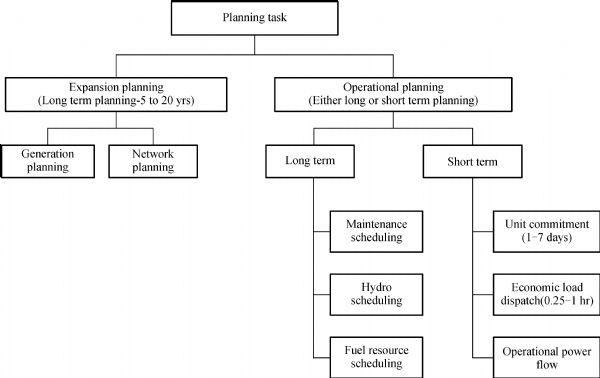

Intelligent optimization of renewable resource mixes incorporating the effect of fuel risk, fuel cost and CO2 emission
Received date: 27 Mar 2014
Accepted date: 12 Jul 2014
Published date: 02 Mar 2015
Copyright
Power system planning is a capital intensive investment-decision problem. The majority of the conventional planning conducted since the last half a century has been based on the least cost approach, keeping in view the optimization of cost and reliability of power supply. Recently, renewable energy sources have found a niche in power system planning owing to concerns arising from fast depletion of fossil fuels, fuel price volatility as well as global climatic changes. Thus, power system planning is under-going a paradigm shift to incorporate such recent technologies. This paper assesses the impact of renewable sources using the portfolio theory to incorporate the effects of fuel price volatility as well as CO2 emissions. An optimization framework using a robust multi-objective evolutionary algorithm, namely NSGA-II, is developed to obtain Pareto optimal solutions. The performance of the proposed approach is assessed and illustrated using the Indian power system considering real-time design practices. The case study for Indian power system validates the efficacy of the proposed methodology as developing countries are also increasing the investment in green energy to increase awareness about clean energy technologies.

Deepak KUMAR , D. K. MOHANTA , M. Jaya Bharata REDDY . Intelligent optimization of renewable resource mixes incorporating the effect of fuel risk, fuel cost and CO2 emission[J]. Frontiers in Energy, 2015 , 9(1) : 91 -105 . DOI: 10.1007/s11708-015-0345-y
| 1 |
Wang X, McDonald J R. Modern Power System Planning. McGraw Hill, 1994
|
| 2 |
Mishra S K, Panda G, Majhi R. Constrained portfolio asset selection using multiobjective bacteria foraging optimization. Operations Research, 2014, 14(1): 113–145
|
| 3 |
Liu S T. A fuzzy modeling for fuzzy portfolio optimization. Expert Systems with Applications, 2011, 38(11): 13803–13809
|
| 4 |
Bazilian M, Roques F. Analytical Methods for Energy Diversity and Security. Elsevier Science, 2008
|
| 5 |
Awerbuch, S. Getting it right: the real cost impacts of a renewables portfolio standard. Public Utilities Fortnightly, 2000-February-15.
|
| 6 |
Awerbuch S. New economic cost perspectives for valuing solar technologies. In: Böer K W ed. Advances in Solar Energy: an Annual Review of Research and Development. Boulder: ASES. 1995
|
| 7 |
Awerbuch S. Market-Based IRP: It’s Easy! Electricity Journal, 1995, 8(3): 50–67
|
| 8 |
Awerbuch S, Berger M. Applying portfolio theory to EU electricity planning and policy-making. International Energy Agency Report number EET/2003/03. 2003
|
| 9 |
Awerbuch S, Dillard J, Mouck T, Preston A. Capital budgeting, technological innovation and the emerging competitive environment of the electric power industry. Energy Policy, 1996, 24(2): 195–202
|
| 10 |
Stirling A. On the economics and analysis of diversity. SPRU Electronic Working Paper No. 28. 1998
|
| 11 |
Krey B, Zweifel P. Efficient electricity portfolios for the United States and Switzerland: an investor view. 2008-10
|
| 12 |
Awerbuch S. The Cost of geothermal energy in the western us regions: a portfolio based approach. Sandia Report SAND2005–5173, Sandia National Laboratories, TN, USA, 2005
|
| 13 |
Anagnostopoulos K P, Mamanis G. The mean–variance cardinality constrained portfolio optimization problem: an experimental evaluation of five multiobjective evolutionary algorithms. Expert Systems with Applications, 2011, 38(11): 14208–14217
|
| 14 |
Gent M R, Lamont J W. Minimum emission dispatch. IEEE Transactions on Power Apparatus and Systems, 2007, PAS-90(60): 2650–2660
|
| 15 |
Deb K, Pratap A, Agarwal S, Meyarivan T. A fast and elitist multiobjective genetic algorithm: NSGA-II. IEEE Transactions on Evolutionary Computation, 2002, 6(2): 182–197
|
| 16 |
Carrano E G, Soares L A E, Takahashi R H C, Saldanha R R, Neto O M. Electric distribution network multiobjective design using a problem-specific genetic algorithm. IEEE Transactions on Power Delivery, 2006, 21(2): 995–1005
|
| 17 |
Srinivas N, Deb K. Multiobjective optimization using nondominated sorting in genetic algorithms. Evolutionary Computation, 1994, 2(3): 221–248
|
| 18 |
Kumar D, Samantaray S R, Kamwa I, Sahoo N C. Reliability-constrained optimal placement of multiple distributed generators in power distribution network using cat-swarm-optimization. Electric Power Components and Systems, 2014, 42(2): 149–164
|
| 19 |
California Energy Commission. Comparative costs of California central station electricity generation technologies (Draft Staff Report). 2007
|
| 20 |
Planning Commission of India. Mid-term appraisal for eleventh five year plan (2007–2012). 2010
|
| 21 |
Planning Commission of India. Approach paper to the twelfth five year plan (2012–2017). 2011-10
|
| 22 |
Corporate Catalyst India. A report on Indian power and energy industry. 2007
|
| 23 |
Ministry of New and Renewable Energy. India. Annual Report 2010–2011.
|
| 24 |
Lazard. Levelized cost of energy analysis. 2009
|
| 25 |
Central Electricity Authority. India. Cost of generation for the year 2008–2009. 2010
|
| 26 |
Central Electricity Authority. India. Growth of electricity sectors in India from 1947–2013. 2013-07
|
/
| 〈 |
|
〉 |